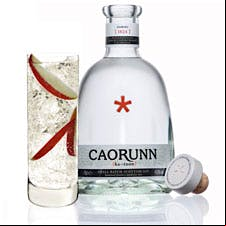Scotch Gin?

The phrase "Scottish spirit" is already a bit nebulous. It can refer to the fervor of a Highlands clansman, to a ghost that haunts the moors in a Gothic novel or to the barley-malt whisky that won world acclaim. Now, you can add some clear spirits to that confusion. Scotland, the cradle of brown liquor, has just added two new gins to its exports.
Caorunn Small Batch Scottish Gin and Edinburgh Gin are spirits that draw from the traditions and terroir of north Britain, but forgo the aging process needed to become a whisky in favor of flavor-infusions with local character. While you usually conjure England in the same thought as gin, it should come as little surprise that Scotland is quite capable of great gin. As well as having long experience in distilling, the country created gin as far back as the eighteenth century-before its controlling neighbor to the south legally denied it that privilege. Of course, it's legal again, and you very well may already drunk gin made Scotland, but carrying the stamp of the category London Dry Gin (for instance, Tanqueray). And a decade ago, the cucumber-flavored Hendrick's bowed in with its Scotch origin proudly emblazoned on the label.
These two newest small-batch gins from Scotland spring from the nation's distilling tradition, using copper stills. They also distinguish themselves by bringing flavors with Scottish connections into the traditional juniper-strong aromatic mix. The two gin producers-Inver House for Caoroon and Spencerfield Spirit Co. in the case of Edinburgh Gin-also have strong backgrounds in single-malt whiskies.
 |
Caorunn (pronounced Ka-roon) is made at the company's Balmenach distillery in Speyside. (The firm also holds Balblair, Speyburn, Old Pulteney and Knockdhu.) The Balmenach site had been shuttered and after reopening was making mainly malts for blending.
Distiller Simon Buley decided he wanted to make something he could drink right now without waiting for it to age. Settling on gin, he took a walk into the countryside to find plants to add to the typical gin recipe. Buley came up with piquant rowanberry (the most dominant), bog myrtle, heather, Coul blush apple and dandelion leaf. (The gin also contains juniper, coriander seed, orange peel, lemon peel, angelica and cassia bark.)
Spencerfield, maker of the boutique Scotch whiskies Sheepdip and Pig's Nose, set out to follow tradition in making Edinburgh Gin, starting with its 200-year-old copper pot still called a "jenny." The makers resurrected a heritage recipe with such familiar botanicals as juniper, coriander, citrus peel, angelica, and orris root. But to that they added a stamp of Scots-ness, using Scottish juniper and adding heather pine and milk thistle to the mix.
Both these Scottish gin insurgents make formidable impressions. They are fresh gins, but with the depth of flavor it takes to shine through even in complex cocktails. We tried both in the Martini format and found their gravity made experimenting with a high vermouth ratios and even adding bitters quite rewarding.
TASTING RESULTS
CAORUNN Small Batch Scottish Gin, $39.99, 41.8 percent alcohol (83.6 proof)
Aroma: Brings a very floral nose with heather, some spice and strong impression of honey.
Taste: The flowers and honey continue to the palate where spices build with a tart berry flavor that adds a lot of excitement on the roof of the mouth.
Finish: As it slowly dries on the palate, honey flavors strengthen with what might be graham cracker if it weren't so crisp and invigorating.
EDINBURGH Gin, $34.99, 43 percent alcohol (86 proof)
Aroma: Lingering just behind the dose of juniper are wildflowers, red fruits, pine, heather and a savory licorice.
Taste: At first, very fruity in the mouth with a hard candy effect. Then if develops the pine of the nose as well the anise and other spices, becoming richer, almost oily.
Finish: The finish recalls the hard candy and some spice and lays out for a length of time extensive for a gin and with unusual depth.


















